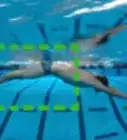This article was co-authored by Alan Fang, a trusted member of wikiHow's volunteer community. Alan Fang swam competitively for over 7 years, through high school and into college. He specialized in breaststroke events, and participated in events such as the Speedo Championship Series, the IHSA (Illinois High School Association) state championships, and Illinois Senior and Age Group state championships.
There are 10 references cited in this article, which can be found at the bottom of the page.
wikiHow marks an article as reader-approved once it receives enough positive feedback. This article received 13 testimonials and 83% of readers who voted found it helpful, earning it our reader-approved status.
This article has been viewed 884,241 times.
Learn more...
The breaststroke is a fun and easy-to-learn swimming technique. Swimming breaststroke is a great form of exercise that engages the arms, legs, shoulders, and neck. There are basically three simple motions. First, kick your legs behind you. Then you just glide for a bit and pull yourself forward with your arms. With some practice, you’ll be swimming the breaststroke in no time.
Steps
Practicing the Core Position
-
1Do a warm-up swim before assuming the core position. Move around in the water for about five minutes before swimming the breaststroke. You could do another swimming stroke you’re familiar with (like the backstroke or freestyle). This will help your muscles warm up and help your body adjust to the water temperature.[1]
- If you don’t know another swimming technique, walk along the bottom of the pool in a section where the water reaches your shoulders. Alternately move your right and left arms out in front of you in clawing motions, pulling water toward you.
-
2Stretch your neck, arms, hips, and legs while in the water. There are many ways to stretch these muscles. For instance, stand on one foot and pull your heel toward your butt. Hold the position for 10 to 15 seconds, then switch to your opposite foot. Repeat on each side three times.[2]
- Stretch your arms by knitting your fingers together, then pushing them straight out in front of you with the palms facing out. Hold the position for 15 seconds, then bring your arms up above your head and hold for another 15 seconds.
- Rotate your hips clockwise for 10 seconds, then rotate them in the opposite direction for another 10 seconds. Repeat three times, then do the same thing for your neck.
Advertisement -
3Start in the core position in the pool. Place yourself laterally in the water with your arms extended straight in front of you and your legs behind you. Your toes should point toward the wall behind you, and your fingers should point toward the wall ahead. With your palms down, splay your thumbs out so that they barely touch. The space between your thumbs and index fingers should form a ‘V.’[3]
- Keep your body high in the water and keep your head pointed down toward the bottom of the pool.
-
4Push off the wall several times and assume the core position. Float in the position for several seconds. This will help you get used to the way your body should feel when you’re in the core position.[4]
- Grip a buoy between your legs if they tend to sink.
- Repeat until you feel confident that you know how to assume the core position.
- Don’t hold the position for longer than you can hold your breath.
Doing the Kick
-
1Do a dry land drill if you need practice doing the breaststroke kick. Lean against a wall with your left hand. Bend your right leg at the knee, bringing the foot toward your butt and bending it upward at the ankle. When your foot is close to your butt, push your right leg out sideways while keeping the knee and ankle bent. After raising your leg at a 45-degree angle, extend your leg and point your toes down, then bring your leg and foot back to the resting position.[5]
- Alternate between your left and right side.
- Continue performing these practice exercises until you feel comfortable with the motion.
- Alternately, you could practice the kick in the water by leaning your arms and body against a paddle board and performing the kick repeatedly.
-
2Begin the kick by pointing your feet outwards from your body. Start from the core position, and rotate your ankles so that your feet are pointed out from your body. Then, bring your heels toward your butt. At the same time, bend your ankles up toward your shins.[6]
-
3Extend your legs out to the side when your heels reach your butt. Extend your knees slightly past the width of your shoulders. Keep your ankles angled up relative to the leg. Extend your legs straight back behind you and bring them back together. Flick your ankles down when you reach the end of the extension.[7]
- If you extend your knees too far to the sides, you’ll cause unnecessary drag on your body. Excess drag will cause you to move less smoothly through the water.
- Turn the soles of your feet inward toward each other as much as possible after flicking your ankles down.
Incorporating the Arm Movements
-
1Sweep your arms out without bending your elbows. Start from the core position, then turn both palms outward. Push your hands out and slightly down. When your arms form a ‘Y’ with your body, bend your elbows and bring your hands down and back toward your mouth. Push them back out and assume the core position again.[8]
-
2Take a breath with every stroke. As you bring your hands toward your mouth, lift your head, neck, and upper chest out of the water to breathe. Do not remove your hands from the water.[9]
- Only bring as much of your head out of the water as necessary to breathe. This will ensure your swimming form stays sleek.
- Exhale through your nose or mouth when your head is back in the water.
- Don’t hold your breath, or you might become tense, which will negatively impact your breaststroke.[10]
-
3Use a pull buoy to provide buoyancy and practice your arm movements. A pull buoy is a flotation device that you can grip between your thighs to keep your legs and body elevated. This will allow you to concentrate on your arms.[11]
-
4
Improving Your Breaststroke
-
1Ensure your limbs are moving together. Both your right and left arms should move in sync during the breaststroke. The same is true of your legs. If you don’t keep your movement balanced and move both corresponding limbs at the same time, you might drift toward one side or the other and your breaststroke will not be smooth.[14]
- Don’t push your arms out too early. After bringing your legs together at the end of the kick phase, allow yourself to glide forward for a second or two. Only then should you pull with your arms.[15]
-
2Go to the gym regularly. The gym is a great place to develop your legs, arms, shoulders, and neck -- the key areas that you use during the breaststroke. Hitting the gym will give you lots of opportunities to do weight training exercises that can help you strengthen your muscles, improve your form, and trim your swim times.
-
3Do a standing double-arm triceps push down. Stand in front of a cable machine and place your hands on top of the bar so that they’re shoulder-width apart. Pull the bar down to a point where your elbows are almost locked, then bring it up to your midline.[16]
- Perform three reps of 10-15 push-downs.
- This exercise mimics the final movement of the initial underwater pull.
-
4Do a barbell biceps curl. Grip the barbell with an underhand grip. Place your hands shoulder-width apart. Curl the bar toward your chest in an arc until it’s level with your shoulders. Slowly lower the bar until your arms are straight again.[17]
- Begin without weight on the bar. After perfecting your technique, slowly add weight in small increments until 10-12 reps is extremely difficult for you.
- Perform three sets of 10-12 reps.
- This exercise will improve the second half of your arm pull motion during the breaststroke.
-
5Do some scapular push-ups. Support your body by balancing on your forearms. Keep your spine straight and point the tips of your toes down. Lower your chest and let your shoulder blades come together. Roll your shoulders to come back up to the starting position.[18]
- Do three sets of 10 scapular pushups.
- This exercise will improve your shoulder strength, making the arm movements of the breaststroke easier.
Expert Q&A
-
QuestionHow do you swim the breaststroke fast?
 Alan FangAlan Fang swam competitively for over 7 years, through high school and into college. He specialized in breaststroke events, and participated in events such as the Speedo Championship Series, the IHSA (Illinois High School Association) state championships, and Illinois Senior and Age Group state championships.
Alan FangAlan Fang swam competitively for over 7 years, through high school and into college. He specialized in breaststroke events, and participated in events such as the Speedo Championship Series, the IHSA (Illinois High School Association) state championships, and Illinois Senior and Age Group state championships.
Former Competitive Swimmer The breaststroke is very much a power stroke. It's known as the slowest stroke because you have to focus on minimizing resistance, rather than just moving as fast as you can. The breaststroke is especially good for people who are short and stocky, and if you want to get really good at it, you need to put on a lot of muscle.
The breaststroke is very much a power stroke. It's known as the slowest stroke because you have to focus on minimizing resistance, rather than just moving as fast as you can. The breaststroke is especially good for people who are short and stocky, and if you want to get really good at it, you need to put on a lot of muscle. -
QuestionSo how long should I take to breathe?
 MoolanCommunity AnswerIt should be a quick. Once you feel gravity pulling you down, it's time to end your breath. Don't try to stay up as doing so will make you tired faster.
MoolanCommunity AnswerIt should be a quick. Once you feel gravity pulling you down, it's time to end your breath. Don't try to stay up as doing so will make you tired faster. -
QuestionDoes my head need to face down during the stroke, or can I look forward underwater? I am practicing breathing through my nose, but it is hard to do facing the floor of the pool.
 Community AnswerYes, your head should face down during the stroke and you can't look forward underwater. You should practice inhaling through your mouth and exhaling through your nose.
Community AnswerYes, your head should face down during the stroke and you can't look forward underwater. You should practice inhaling through your mouth and exhaling through your nose.
Warnings
- If your start to cramp up and feel tightness in your arms or legs, get out of the water for a bit and walk around.⧼thumbs_response⧽
References
- ↑ http://www.swimming.org/justswim/guide-stretching-warming/
- ↑ http://www.swimming.org/justswim/guide-stretching-warming/
- ↑ https://breakingmuscle.com/fitness/swim-basics-a-beginners-guide-to-the-breaststroke
- ↑ https://breakingmuscle.com/fitness/swim-basics-a-beginners-guide-to-the-breaststroke
- ↑ http://www.enjoy-swimming.com/breaststroke-kick-dry-land-exercises.html
- ↑ https://breakingmuscle.com/fitness/swim-basics-a-beginners-guide-to-the-breaststroke
- ↑ https://breakingmuscle.com/fitness/swim-basics-a-beginners-guide-to-the-breaststroke
- ↑ http://www.enjoy-swimming.com/breast-stroke.html
- ↑ https://breakingmuscle.com/fitness/swim-basics-a-beginners-guide-to-the-breaststroke
- ↑ http://www.enjoy-swimming.com/breaststroke.html
- ↑ https://breakingmuscle.com/fitness/swim-basics-a-beginners-guide-to-the-breaststroke
- ↑ https://www.myactivesg.com/sports/swimming/training-method/swimming-for-beginners/how-to-swim-breast-stroke
- ↑ https://breakingmuscle.com/fitness/swim-basics-a-beginners-guide-to-the-breaststroke
- ↑ https://www.arenawaterinstinct.com/en_uk/community/training-technique/6-mistakes-to-avoid-if-you-want-to-improve-your-breaststroke/
- ↑ https://www.theguardian.com/lifeandstyle/2008/jul/30/fitness
- ↑ http://lifeasaninvestment.com/2015/10/15/dry-land-exercises-for-swimmers-breaststroke/
- ↑ http://lifeasaninvestment.com/2015/10/15/dry-land-exercises-for-swimmers-breaststroke/
- ↑ http://lifeasaninvestment.com/2015/10/15/dry-land-exercises-for-swimmers-breaststroke/
About This Article
To swim the breaststroke, start by learning the kicking movement. When you push off from the wall, point your feet out from your body, and then bring your heels toward your butt. When your heels reach your butt, extend your knees slightly out to the side, and then then kick your legs straight back before bringing them together. After 2 seconds of gliding, push your arms into a “Y” position and bring them toward you as you lift your head to breathe. For tips on mastering the core position of the stroke and getting a faster time, read on!
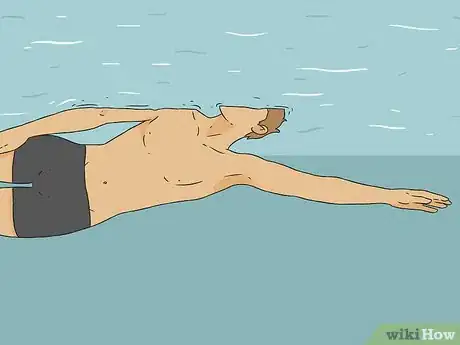
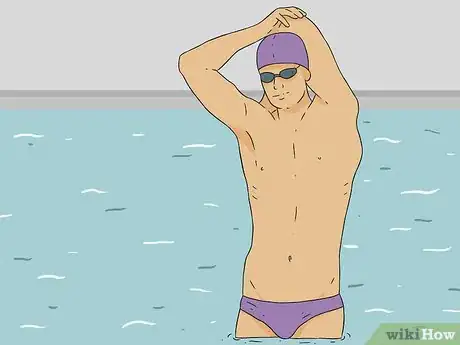
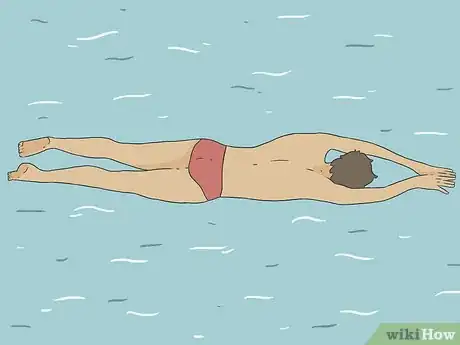
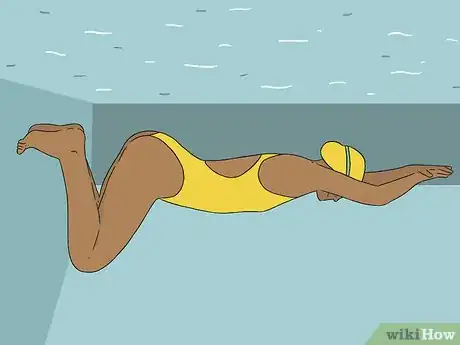
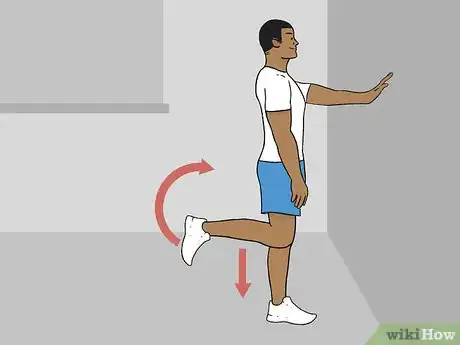
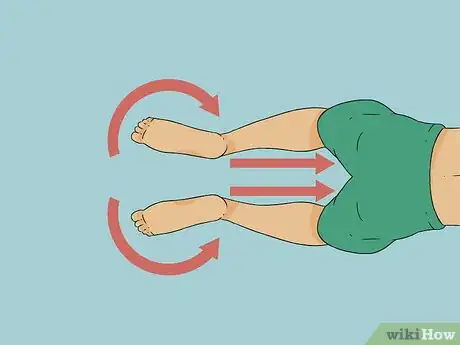
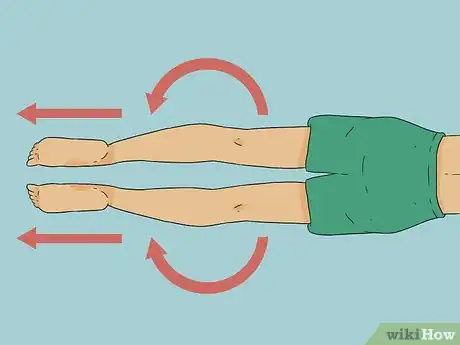
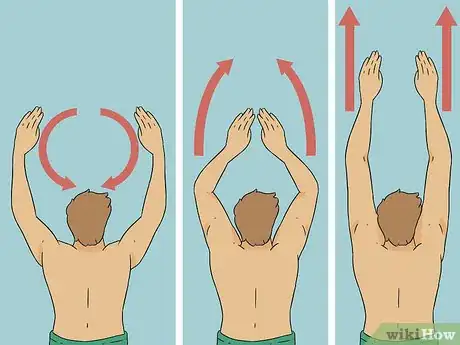
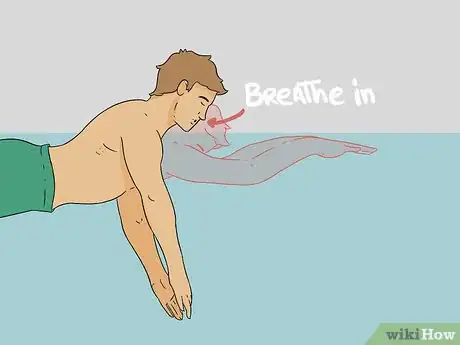
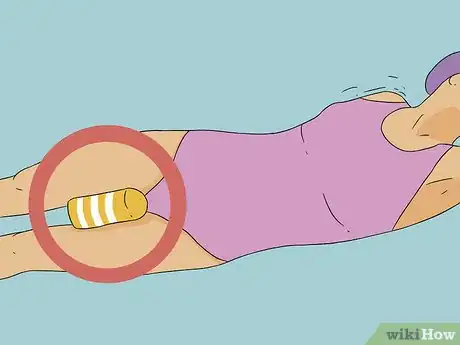
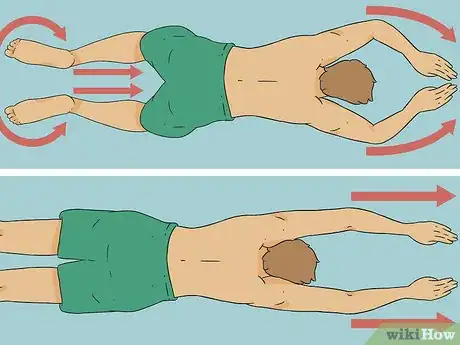
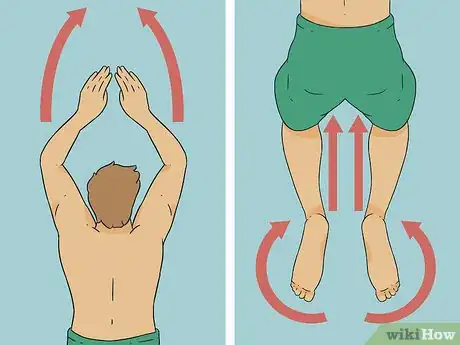
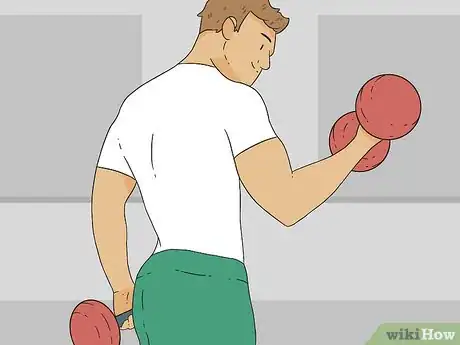
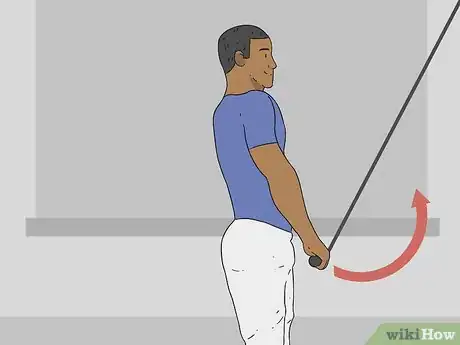
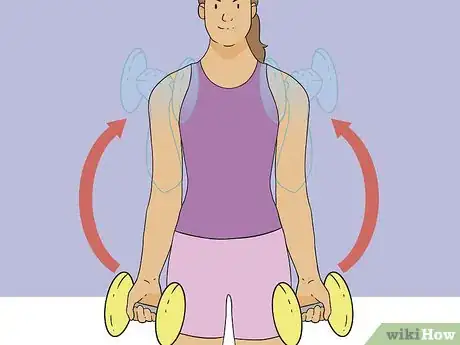
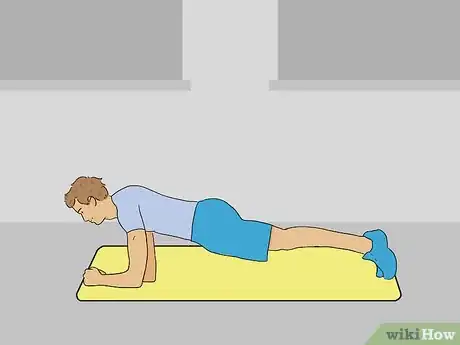
-Step-11.webp)

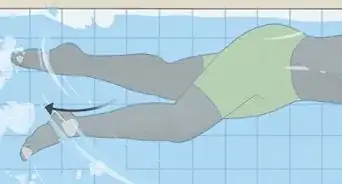


-Step-7-Version-2.webp)
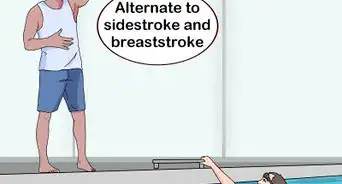
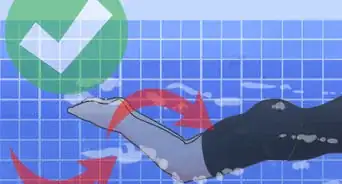
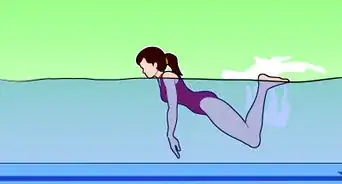










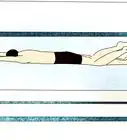
-Step-11.webp)
